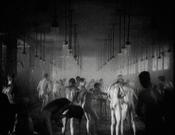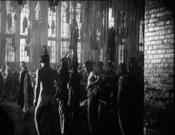The Poetology of Weimar Cinema
How can the very different films of a period be viewed together? Can a poetology of this cinema be identified that goes beyond ideological classifications? How can films provide information about the time in which they were made? And why should one be able to see more or different things in a film than in the attentive observation of everyday life?
These problems are discussed from Kracauer through Deleuze to Rancière and keep developing with regard to a recurring, concrete research object – the Weimar Cinema – a theoretical perspective, in which the question of the relation of films to their historical situation can be posed anew as a question of a (specific) cinematic thinking.
The Furnished Human
Der möblierte Mensch fundamentally rereads Georg Wilhelm Pabst’s films, in order to work out and understand a central motive of the Weimar Cinema’s aesthetic: The utopia of objectivity.
This utopia envisions an art, in which the spiritual is rooted in external reality, and subjective perception in the materiality of the everyday world. The contradictions of the aesthetics of New Objectivity – between phantasm and external reality, objectivity and the constructivist ideal of representation – are worked out through detailed film analyses as the poetology of the Weimar auteur cinema. The heterogeneity of the Weimar cinema – the oscillation between melodramatic, expressionistic, realistic, and fantastical stylistic elements – is understood as an aesthetic form through the various analyses of G. W. Pabst’s films and thus opens up a poetological perspective onto the specific aesthetic consciousness of this epoch, which unfolds beyond ideological boundaries.
Thinking in images – not as intentional content but rather as a mental process whose temporal structure is located within the images themselves – manifests itself in the aesthetic construction of Pabst’s films. They possess connections to Eisenstein’s montage theory, Brecht’s dramaturgy, and Ihering’s understanding of the stage space. The resolution of spatial-figurative structures into a contrast of light and shadow within a dynamized image space proves typical for the Weimar Cinema. The Weimar auteur cinema’s central ideas are best captured in Gilles Deleuze’s “never-ending opposition” of a bright darkness. With Deleuze, the camera look can be grasped as an independent, potentially unlimited cinematographic consciousness; seeing turns into aesthetic reflexivity. The thinking in images can thus be understood as the thinking of the images which take possession of the spectators.
Following Deleuze’s theory of the time-image and movement-image, Der möblierte Mensch aims at a poetology of the Weimar cinema that is no longer based on concepts of work and auteur. Rather, an effort was made to read the films of the so-called New Realism as a surface of resonance, in which opposing aspirations of aesthetic thought and its political implications become tangible. This tension can be understood as the aesthetic disposition of the Weimar auteur cinema.
Further information about the book: Der möblierte Mensch
"Saint-Avit finishes his story, his opposite extinguishes the oil lamp; there are still two hours until morning roll call, during which time he will write the letter. He gazes into the expanse before him: the shimmering sand dunes, from which the light seems to rise in thin veils. [....]
A camera pan, Saint-Avit comes back into the picture, opposite him, with his back to the camera, the Tuareg. Only now do we see what made Saint-Avit pause, the black-veiled face. [...] At the end of the scene, an image - framed by the archway it shows the glistening, bright plain. We see the black figure riding away; Saint-Avit, he might be staring at this image. Then once again the image in the archway, like a prospect, attached to the fortress wall: the gentle wave lines of the sand dunes fade into the light. A close-up shows Saint-Avit. Slowly, his facial features dissolve. The camera glides over the sand in one swift movement; we see traces pressed into the fine-grained surface. [...]
A search party sets off from the fort. The troop can be seen disappearing into the lower edge of the picture against a vast horizon, then the soldiers cross the sand dunes on their camels at a stretched gallop. The sand drifts over the bumps in thin plumes. Music begins, intonating the distorted tones of an approaching storm. It swells - a timid howl, a roar. A thick veil covers the image. [...] The officer stands leaning against the wind, holding the billowing cloth over his head. You can see his figure at the edge of the picture - fluttering white and gray cloths. His voice can be heard in the howling cascades of music. He calls out the name Saint-Avits. The camera moves a little further, the image fades into a shimmering, fine-grained gray. The film ends like the radio broadcast, it fades into noise.
Light and shadow dissolve into a long shot, which was given from the outset in the empty expanse of space, the staged silence - that too is the gliding. At the beginning, the image of the desert still shows contours. [...] Later there are only the sand dunes, the brightly shimmering undulating surface of a shoreless sea, where sometimes a pale line appears, the horizon [...]. The sandstorm erases all form, the trace that leads back to the subterranean city.
The Lady of Atlantis leads the chiaroscuro into pure abstract figuration. Its metamorphosis across the vast landscape, the shadowy world of the cave into the white light, dissolves the opposition of good and evil, man and nature, being and appearance into the polarities of the pure pictorial structure: surface, line - black and white. It allows perception to think of the figurative, the shape and the representational as the results of mental operations; it leads into this thinking." (translation of Der möblierte Mensch, p.221 f.)
The Image Idea of the New Objectivity
The essay Eine neue Gegenständlichkeit – Die Bildidee der Neuen Sachlichkeit und der Film views New Objectivity not as a style-historical epoch, but rather as an aesthetic disposition of the Weimar cinema. Independently from each specific expression, a reflective discovery of the new medium’s imagery takes place in all advanced films of the period, which centers a new objectivism.
"Die Kunst der neuen Sachlichkeit will einen eigenständigen Blick auf die Welt installieren, ein Sehen, dem die Interpretationsmuster menschlicher Wahrnehmung genommen sind: […] [das] poetische Konzept, das eine Wirklichkeit zur Darstellung bringen will, deren Bewusstsein noch aussteht." (S. 136)
"The art of the New Objectivity aims to establish an independent perspective on the world, a vision stripped of the interpretative patterns of human perception: [...] [the] poetic concept that aims to depict a reality whose consciousness is yet to be realized." (p. 136)
(Eine neue Gegenständlichkeit – Die Bildidee der Neuen Sachlichkeit und der Film. In: Diesseits der >Dämonischen Leinwand<. Neue Perspektiven auf das späte Weimarer Kino. Edited by Thomas Koebner together with Norbert Grob and Bernd Kiefer. edition text + kritik, 2003)
Carl Mayer
Based on the screenwriter Carl Mayer, who achieved unique prominence as an author in Weimar cinema for his screenplays, the essay Geschriebene Bewegungsbilder - Der Filmdichter Carl Mayer discusses how a completely new visual idea emerges in the films of the New Objectivity.
With his screenplays, in which he primarily gives film-aesthetic instructions and increasingly reduces the description of the plot, Carl Mayer dedicates himself to the investigation of a new cinematographic imagery. He uses film-technical instructions in a poetic way and thus realizes the movement of the cinematic image as a linguistic arrangement. Carl Mayer's idea of a film without intertitles and his focus on 'film-like' narration allow the image itself in its movement to become a form of articulation of time, and the space of the cinematographic image emerges as a world completely permeated by consciousness.
Walter Benjamin
The essay Der Lesende im Kino. Allegorie, Fotografie und Film bei Walter Benjamin works out, as to what extent, according to Benjamin, a specific reception mode is required, in order to perceive the thinking of films. The essay condenses Benjamin’s combination of photography and allegory to the following thesis for the cinema: either the spectators learn to read the images, to recognize them as writing, as a cerebral connection of intelligent senses with which mental operations can be carried out – or they immerse themselves in the reality of the imaginary, the illusion.
The film emerges through its specific design of viewing and hearing as its own form of consciousness which enables everyday perception to step into the mode of writing. Through this ‘literarization of all circumstances of living,‘ the cinema would be the space, in which social life were to make itself readable.
"Der Film lässt Wahrnehmbarkeiten und Hörbarkeiten auftauchen, die außerhalb der gegebenen Form unserer Wahrnehmung liegen. Das ist es, was für Benjamin den Film ausmacht, seine paradigmatische Stellung innerhalb der Ästhetik und sein intelligibles Potenzial: Das Kino gibt uns mit der Alltagswelt, der äußeren Wirklichkeit, der sozialen Realität den geistigen Kosmos eines ausstehenden Denkens, eines unausdenkbaren Lebens zu verstehen."
"Film allows perceptibilities and audibilities to emerge that lie outside the given form of our perception. This is what constitutes film for Benjamin, its paradigmatic position within aesthetics and its intelligible potential: with the everyday world, external reality, social reality, cinema gives us an understanding of the intellectual cosmos of a pending thought, of an unthinkable life."
(Der Lesende im Kino. Allegorie, Fotografie und Film bei Walter Benjamin. In: Die Spur durch den Spiegel. Der Film in der Kultur der Moderne / Malte Hagener, Johann N. Schmidt, Michael Wedel (eds.). First edition. Berlin: Bertz + Fischer, 2004.)
Siegfried Kracauer
In the essay Realität lesen. Das Kino und die Politik des Ästhetischen, Siegfried Kracauer’s From Caligari to Hitler is reread based on the basis of Rancière's concept of politics. At the end of the essay, an analysis of Fassbinder illustrates how social reality is aesthetically inscribed in film and only becomes recognizable there. The essay begins with Jacques Rancière’s Politics of the Aesthetics (see The Aesthetics and Politics of Audiovisual Images). Rancière's particular concept of politics is based on the aesthetic objection to the limitations of everyday perception. For Rancière, art is thus a cultural practice that offers space to a hitherto unrecognized sensuality and articulates an objection to the existing. Rancière assigns a special role to film, because it fulfills the program of modern aesthetics: everything that constitutes the physical-sensual life of the community, everything that it feels, can be a direct thought in film and everything that it thinks can be a direct feeling. Rancière thus recapitulates the utopia of the vividness of the social in classical film theory.
In his work From Caligari to Hitler, Kracauer examines films of the Weimar republic with regard to the question of how the social forces that would later lead to fascism are already evident in the films of this era. A fundamental premise of the book is that such forces are already visible in the cinema before they noticeably manifest themselves in societal reality. This has to do with the fundamental change of perspective which rings through Kracauer’s work: the cinematic image is not understood as an image of social reality, but rather as a medium with which this reality may be understood as a physical-sensorial being-in-the-world. In short, it can be said that in film the ‘inner life’ of a society, the social reality, becomes visible and tangible at the surface: within the characters’ postures and gestures, within the spaces in which the characters are put into relation with one another.
(Realität lesen. Das Kino und die Politik des Ästhetischen. In: Unerhörte Erfahrung. Texte zum Kino. Doris Kern und Sabine Nessel (eds.), Frankfurt a.M. 2008)
An example of Kracauer’s specific way of thinking – the becoming recognizable of social reality in a film’s gestures or spaces – comes from from the Caligari-book. There, it says the following about a scene from the G. W. Pabst-film Kameradschaft (Germany 1931):
„Mit Kameradschaft fand Pabst wieder zur eigenen Linie. Sein angeborener Sinn für Realität setzt sich eindrucksvoll in der Duschraum-Episode durch. Das Wasser aus den Duschen sprüht durch den ganzen Raum und umhüllt die nackten Bergleute wie auch die Reihen von Kleidern, die von der hohen Decke herabhängen wie geisterhafte Tierkadaver über den glänzend eingeseiften menschlichen Körpern. Nichts scheint in dieser Episode inszeniert zu sein, ja, das Publikum wird in einen Arkanbereich des Alltags eingelassen. Die im Studio nachgebaute Zeche liefert die völlige Illusion eines Gesteins unter Tage. Ernö Metzner, für die Bauten verantwortlich, bemerkte, daß Dokumentaraufnahmen eines wirklichen Grubenunglücks kaum einen überzeugenden Eindruck davon gegeben hätten. >Für diesen Fall kam die Natur als Modell fürs Studio nicht in Frage.< Schreckliche Realität ist von dem Schein, mit dem sie unsere Einbildung umgibt, unablösbar.“ Kracauer: Von Caligari zu Hitler, S. 253.)





